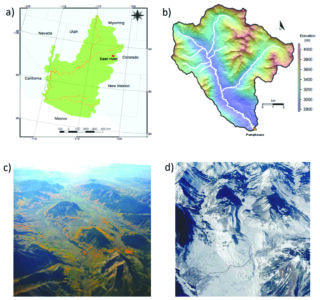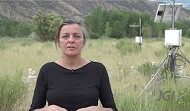Biogeochemical dynamics from genomes to watershed scales
Project website | Overview brochure PDF
Principal investigator: Eoin Brodie

East River Watershed. (a) Watershed location within the Upper Colorado River Basin; (b) elevation map; (c) aerial view of the East River during the growing season (courtesy Joseph Guardiola); and (d) aerial view during the winter season (courtesy Sam Faivre). [Reprinted via a Creative Commons license (CC BY-NC-ND 4.0) from Hubbard, S. S., et al. 2018. “The East River, Colorado, Watershed: A Mountainous Community Testbed for Improving Predictive Understanding of Multiscale Hydrological-Biogeochemical Dynamics,” Vadose Zone Journal, DOI: 10.2136/vzj2018.03.0061.]
Extreme weather, climate change, drought, fire, and other disturbances are significantly reshaping interactions within watersheds throughout the world. Watersheds are recognized as Earth’s key functional unit for managing water resources, but their hydrological interactions also mediate biogeochemical processes that influence water quality and support all terrestrial life. Complex interactions between microbes, minerals, fluids, dissolved constituents, and plants occur across bedrock-to-canopy and terrestrial-aquatic continuums. These interactions lead to a cascade of effects on downstream water availability, nutrient and metal loading, and carbon and nitrogen cycling. The nature of these interactions, including their response to disturbance, varies throughout the watershed. Despite significant implications for energy production, agriculture, water quality, and other societal benefits important to U.S. Department of Energy (DOE) energy and environmental missions, uncertainty associated with predicting watershed hydro-biogeochemistry and its dynamic response to disturbance remains high. To address this uncertainty, the Environmental System Science program within DOE’s Office of Biological and Environmental Research (BER), is supporting the Watershed Function Science Focus Area (SFA).
Watershed Function SFA research focuses on the snow-dominated, high-elevation East River Watershed of the Upper Colorado River Basin. Streamflow originating from snowpack feeds much of the Colorado River, which in turn provides water to one in 10 Americans across seven western states and hydroelectric power to millions, irrigates over 5.5 million acres of agriculture, and supports over $1 trillion per year of economic activity. The complexity and vulnerability of this river basin to disturbance are emblematic of other high-mountain regions worldwide.
SFA Grand Challenge and Priorities
The Watershed Function SFA is developing a predictive understanding of how mountainous watersheds retain and release water, nutrients, and metals, with a focus on the impacts of droughts, floods, early snowmelt, and other perturbations on downstream water availability and biogeochemical cycling over subseasonal, seasonal, and decadal timescales.

Predictive Understanding of Complex Mountainous Watersheds. The aggregated concentration-discharge (C-Q) response of mountainous watersheds to snow dynamics involves a variety of multiphysics, multiscale processes occurring from bedrock to canopy, across land-water interfaces, and along steep hydrogeochemical gradients. The Watershed Function SFA is developing an extensible approach and new capabilities to quantify these interactions, with the goal of predicting aggregated water and solute exports accompanying disturbance. Process-based investigations are paired with mechanistic models to discover how distributed hillslope ecohydrogeological and river corridor subsystems respond to snow variability. Transferable new approaches are being developed for predicting the aggregated watershed behavior, including a system-of-systems functional zone construct based on a 4D digital twin of the watershed and machine-learning approaches, as well as scale-adaptive and functional zone simulation approaches.
The current phase focuses on addressing how snow accumulation and distribution and snowmelt timing influence watershed hydrobiogeochemical dynamics through three research priorities: predicting how snow dynamics impact aggregated water (Priority 1) and nitrogen (Priority 2) exports, and defining and testing a functional zone approach (Priority 3) for enabling tractable characterization and prediction of aggregated exports in response to snow dynamics.
“System-of-Systems” Functional Zone Approach
To address the enormous heterogeneity inherent in mountainous watersheds, the Watershed Function SFA takes a system-of-systems approach. Remotely sensed and ground-based information is used to develop a four-dimensional (4D) East River Watershed digital twin, and machine-learning approaches are used to identify key subsystems or “functional zones” within that watershed. The functional zones are hypothesized to have unique properties that influence that zone’s response to disturbance, including associated exports. Working within representative functional zones across the East River, process-based investigations paired with models are advancing a predictive understanding of distributed hillslope ecohydrogeological and river corridor responses to disturbances. A scale-adaptive watershed simulation capability (SAWaSC) is also being developed to enable “telescoping” into regions that may have an outsized impact on larger watershed response to snow dynamics. Together, the scale-adaptive and functional zone approaches are expected to provide novel, site agnostic, and computationally efficient means for predicting changes in complex system behavior in a manner that is scalable from watersheds to basins. A new “co-design” strategy is also being developed to seamlessly marry hardware; diverse, multiscale, and increasingly autonomous watershed data; and mechanistic, multiscale watershed models. The goal is to enable near real-time assimilation of field data into models and model-informed guidance of field data collection.
Collaborative Watershed Science
Led by Berkeley Lab, the multidisciplinary, multi-institutional SFA combines expertise in reactive transport and watershed modeling, environmental genomics and ecosystems biology, plant physiology, environmental geophysics, vadose zone hydrology, low-temperature and isotope geochemistry, data science, and environmental synchrotron science. The project involves key collaborations with investigators from three national laboratories, 28 universities, six federal and state agencies, three local stakeholders, and six small businesses, providing extensive leveraging of support from BER and others.
Alignment with BER Grand Challenges
The Watershed Function SFA is particularly well aligned with three of the grand challenges being addressed by BER’s Climate and Environmental Sciences Division. These include the Integrated Water Cycle, Biogeochemistry, and Data-Model Integration challenges. The project’s basic research also has relevance to many broader themes, including water in the West, integrated mountainous hydrology, and changing hydrology and water quality. In addition to the SFA’s expected scientific outcomes, the project is committed to building community, capacity, and a distributed watershed philosophy.
Videos
Introduction - Watershed Function SFA
A LBNL team studies ecosystem changes in a research area along the East River catchment near the Upper Colorado River headwaters.
Plants as Sensors - Watershed Function SFA
A LBNL team studies changes to plant communities along the East River catchment near the Upper Colorado River headwaters.
Nitrogen Worlds - Watershed Function SFA
LBNL scientists are working to identify major inputs and exports of nitrogen in a pristine East River, Colorado, watershed system.
4D Digital Watersheds
LBNL researchers study ecosystem changes in a research area along the East River catchment near the Upper Colorado River headwaters.
Characterizing Rifle Subsurface Microbes
LBNL’s Jill Banfield on how the DOE JGI advanced her research on the roles of subsurface microbial communities in biogeochemical cycling (2015).
Metabolic Potential
LBNL researchers discuss how metabolic lifestyles of microbial communities modulate in response to as well as influence environmental change. (2015)
Watershed Structure and Controls
LBNL’s Ken Williams discusses identification and monitoring of primary factors that control biogeochemical functioning. (2015)








